Project Management and Consultancy: Flip-Flop Factory Business Plan
VerifiedAdded on 2023/01/16
|39
|7575
|55
Project
AI Summary
This research proposal outlines the development of a comprehensive business plan for a flip-flop factory in Jharkhand, India, under Thriveni Apparels and Textiles Limited. The project focuses on leveraging the growing Indian footwear market, particularly the demand for flip-flops, while integrating sustainable practices and principles of a circular economy. The research encompasses a detailed market analysis of the Indian footwear industry, exploring opportunities in Jharkhand, and identifying potential routes to market. Academic models like PESTLE analysis and the 7Ps of Marketing are used to inform strategic decisions. The proposal also covers resource planning, ethical considerations, and risk assessment, with milestones outlined using a Gantt chart. The core objective is to create a self-sustaining business model that generates employment opportunities, especially for women in the region, contributing to socio-economic development. The plan aims to address the gap in the market and expand the business while incorporating sustainable practices and circular economy principles.
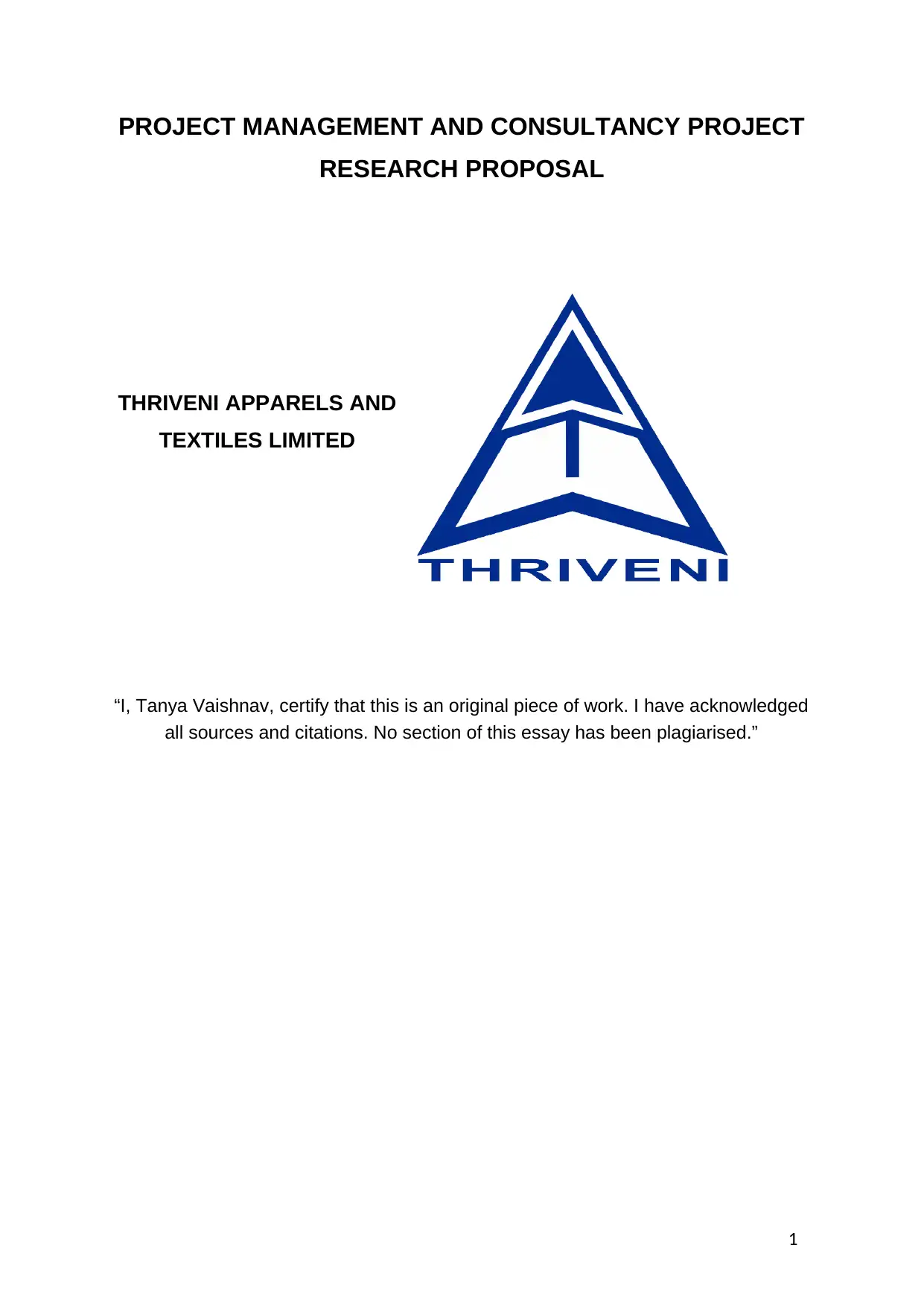
PROJECT MANAGEMENT AND CONSULTANCY PROJECT
RESEARCH PROPOSAL
THRIVENI APPARELS AND
TEXTILES LIMITED
“I, Tanya Vaishnav, certify that this is an original piece of work. I have acknowledged
all sources and citations. No section of this essay has been plagiarised.”
1
RESEARCH PROPOSAL
THRIVENI APPARELS AND
TEXTILES LIMITED
“I, Tanya Vaishnav, certify that this is an original piece of work. I have acknowledged
all sources and citations. No section of this essay has been plagiarised.”
1
Paraphrase This Document
Need a fresh take? Get an instant paraphrase of this document with our AI Paraphraser
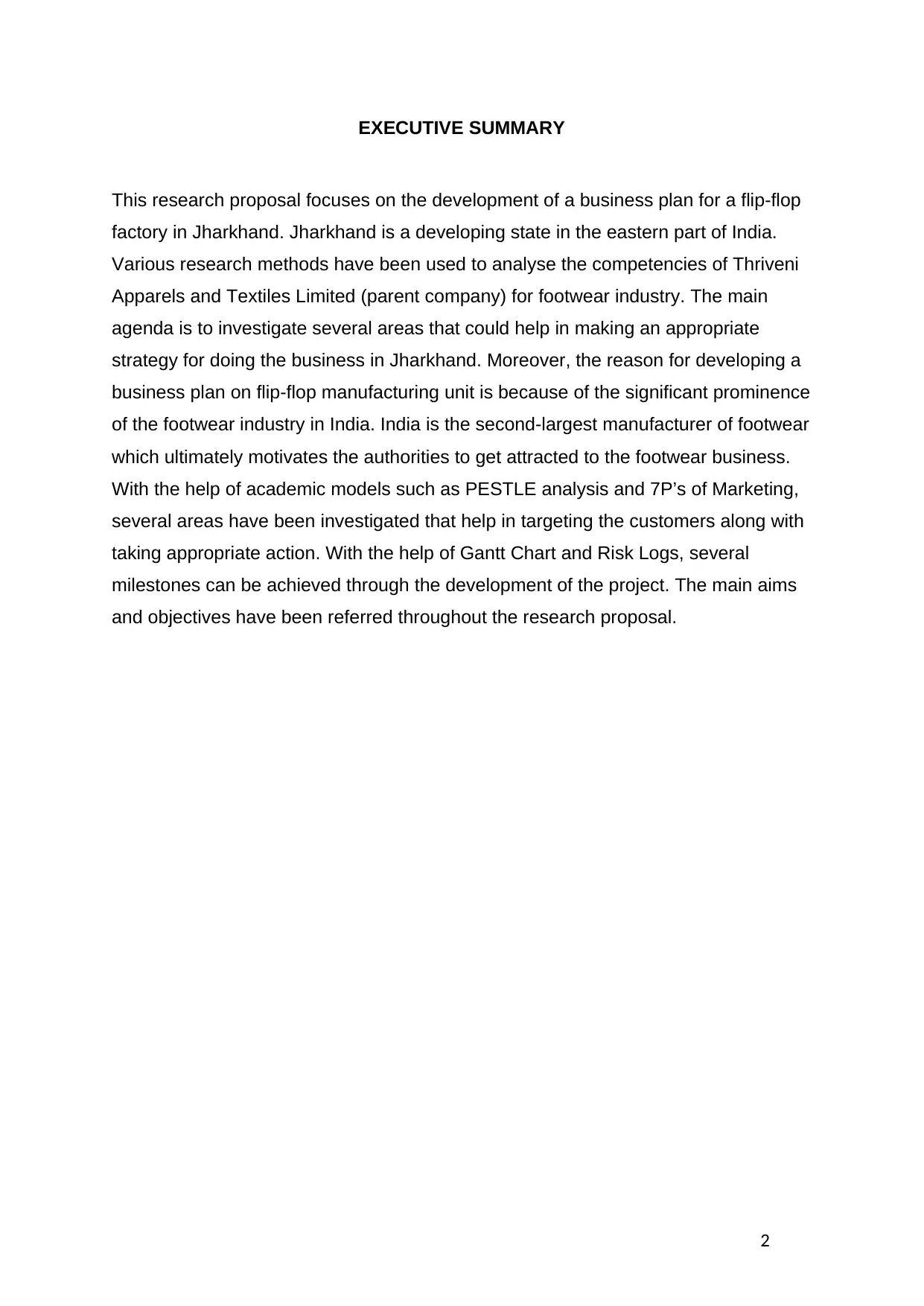
EXECUTIVE SUMMARY
This research proposal focuses on the development of a business plan for a flip-flop
factory in Jharkhand. Jharkhand is a developing state in the eastern part of India.
Various research methods have been used to analyse the competencies of Thriveni
Apparels and Textiles Limited (parent company) for footwear industry. The main
agenda is to investigate several areas that could help in making an appropriate
strategy for doing the business in Jharkhand. Moreover, the reason for developing a
business plan on flip-flop manufacturing unit is because of the significant prominence
of the footwear industry in India. India is the second-largest manufacturer of footwear
which ultimately motivates the authorities to get attracted to the footwear business.
With the help of academic models such as PESTLE analysis and 7P’s of Marketing,
several areas have been investigated that help in targeting the customers along with
taking appropriate action. With the help of Gantt Chart and Risk Logs, several
milestones can be achieved through the development of the project. The main aims
and objectives have been referred throughout the research proposal.
2
This research proposal focuses on the development of a business plan for a flip-flop
factory in Jharkhand. Jharkhand is a developing state in the eastern part of India.
Various research methods have been used to analyse the competencies of Thriveni
Apparels and Textiles Limited (parent company) for footwear industry. The main
agenda is to investigate several areas that could help in making an appropriate
strategy for doing the business in Jharkhand. Moreover, the reason for developing a
business plan on flip-flop manufacturing unit is because of the significant prominence
of the footwear industry in India. India is the second-largest manufacturer of footwear
which ultimately motivates the authorities to get attracted to the footwear business.
With the help of academic models such as PESTLE analysis and 7P’s of Marketing,
several areas have been investigated that help in targeting the customers along with
taking appropriate action. With the help of Gantt Chart and Risk Logs, several
milestones can be achieved through the development of the project. The main aims
and objectives have been referred throughout the research proposal.
2
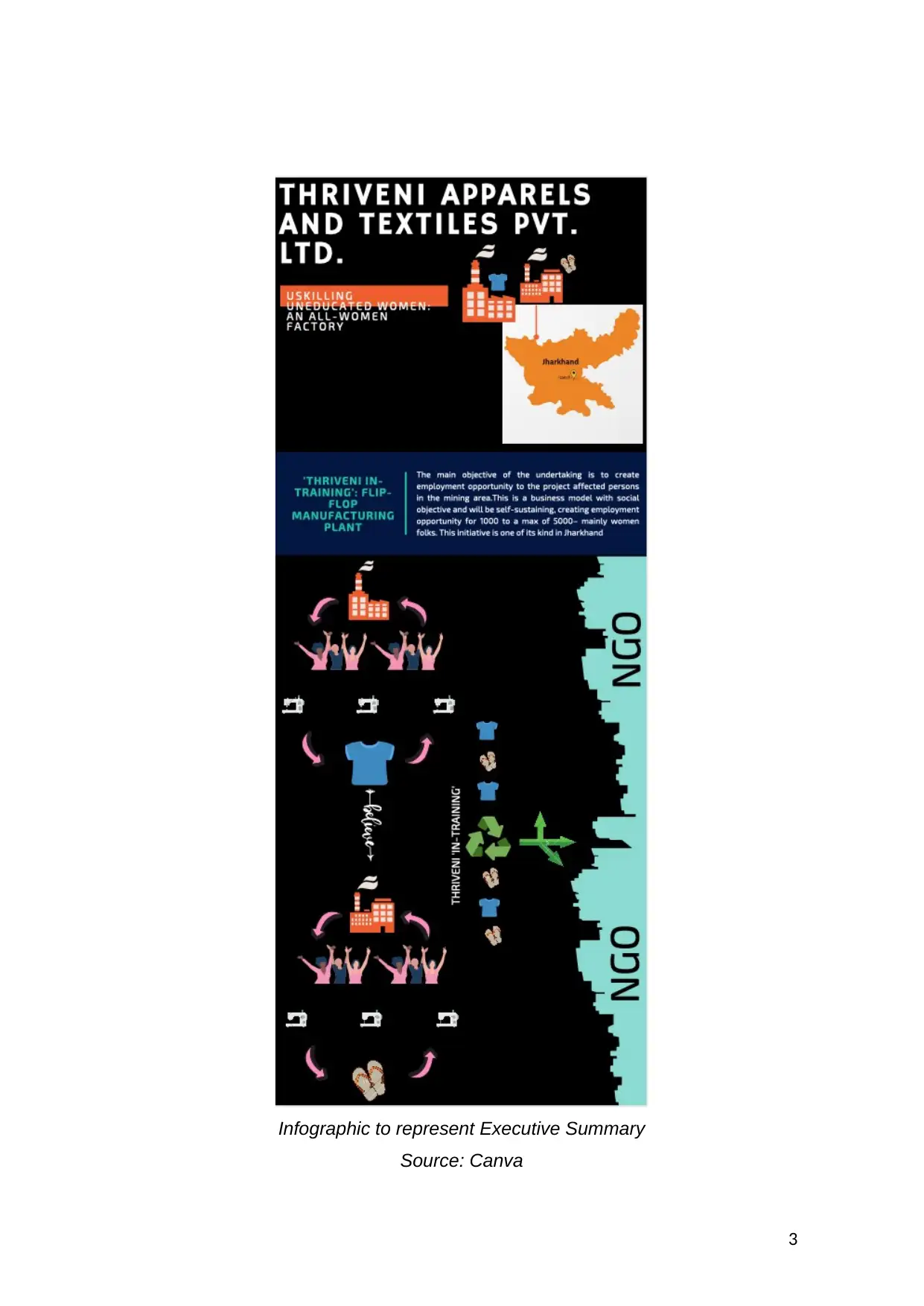
Infographic to represent Executive Summary
Source: Canva
3
Source: Canva
3
⊘ This is a preview!⊘
Do you want full access?
Subscribe today to unlock all pages.

Trusted by 1+ million students worldwide
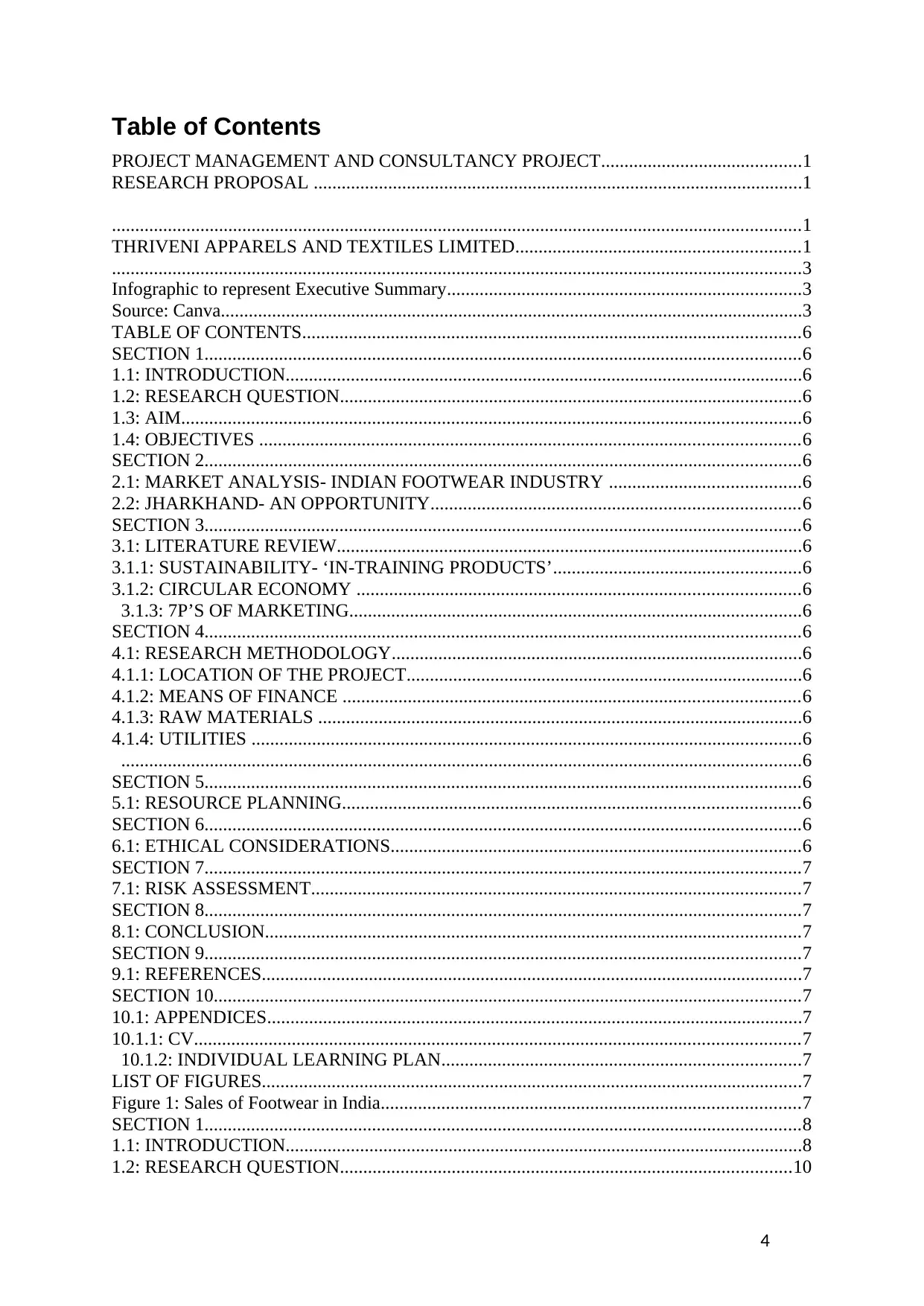
Table of Contents
PROJECT MANAGEMENT AND CONSULTANCY PROJECT...........................................1
RESEARCH PROPOSAL .........................................................................................................1
....................................................................................................................................................1
THRIVENI APPARELS AND TEXTILES LIMITED.............................................................1
....................................................................................................................................................3
Infographic to represent Executive Summary............................................................................3
Source: Canva.............................................................................................................................3
TABLE OF CONTENTS...........................................................................................................6
SECTION 1................................................................................................................................6
1.1: INTRODUCTION...............................................................................................................6
1.2: RESEARCH QUESTION...................................................................................................6
1.3: AIM.....................................................................................................................................6
1.4: OBJECTIVES ....................................................................................................................6
SECTION 2................................................................................................................................6
2.1: MARKET ANALYSIS- INDIAN FOOTWEAR INDUSTRY .........................................6
2.2: JHARKHAND- AN OPPORTUNITY...............................................................................6
SECTION 3................................................................................................................................6
3.1: LITERATURE REVIEW....................................................................................................6
3.1.1: SUSTAINABILITY- ‘IN-TRAINING PRODUCTS’.....................................................6
3.1.2: CIRCULAR ECONOMY ...............................................................................................6
3.1.3: 7P’S OF MARKETING.................................................................................................6
SECTION 4................................................................................................................................6
4.1: RESEARCH METHODOLOGY........................................................................................6
4.1.1: LOCATION OF THE PROJECT.....................................................................................6
4.1.2: MEANS OF FINANCE ..................................................................................................6
4.1.3: RAW MATERIALS ........................................................................................................6
4.1.4: UTILITIES ......................................................................................................................6
..................................................................................................................................................6
SECTION 5................................................................................................................................6
5.1: RESOURCE PLANNING..................................................................................................6
SECTION 6................................................................................................................................6
6.1: ETHICAL CONSIDERATIONS........................................................................................6
SECTION 7................................................................................................................................7
7.1: RISK ASSESSMENT.........................................................................................................7
SECTION 8................................................................................................................................7
8.1: CONCLUSION...................................................................................................................7
SECTION 9................................................................................................................................7
9.1: REFERENCES....................................................................................................................7
SECTION 10..............................................................................................................................7
10.1: APPENDICES...................................................................................................................7
10.1.1: CV..................................................................................................................................7
10.1.2: INDIVIDUAL LEARNING PLAN.............................................................................7
LIST OF FIGURES....................................................................................................................7
Figure 1: Sales of Footwear in India..........................................................................................7
SECTION 1................................................................................................................................8
1.1: INTRODUCTION...............................................................................................................8
1.2: RESEARCH QUESTION.................................................................................................10
4
PROJECT MANAGEMENT AND CONSULTANCY PROJECT...........................................1
RESEARCH PROPOSAL .........................................................................................................1
....................................................................................................................................................1
THRIVENI APPARELS AND TEXTILES LIMITED.............................................................1
....................................................................................................................................................3
Infographic to represent Executive Summary............................................................................3
Source: Canva.............................................................................................................................3
TABLE OF CONTENTS...........................................................................................................6
SECTION 1................................................................................................................................6
1.1: INTRODUCTION...............................................................................................................6
1.2: RESEARCH QUESTION...................................................................................................6
1.3: AIM.....................................................................................................................................6
1.4: OBJECTIVES ....................................................................................................................6
SECTION 2................................................................................................................................6
2.1: MARKET ANALYSIS- INDIAN FOOTWEAR INDUSTRY .........................................6
2.2: JHARKHAND- AN OPPORTUNITY...............................................................................6
SECTION 3................................................................................................................................6
3.1: LITERATURE REVIEW....................................................................................................6
3.1.1: SUSTAINABILITY- ‘IN-TRAINING PRODUCTS’.....................................................6
3.1.2: CIRCULAR ECONOMY ...............................................................................................6
3.1.3: 7P’S OF MARKETING.................................................................................................6
SECTION 4................................................................................................................................6
4.1: RESEARCH METHODOLOGY........................................................................................6
4.1.1: LOCATION OF THE PROJECT.....................................................................................6
4.1.2: MEANS OF FINANCE ..................................................................................................6
4.1.3: RAW MATERIALS ........................................................................................................6
4.1.4: UTILITIES ......................................................................................................................6
..................................................................................................................................................6
SECTION 5................................................................................................................................6
5.1: RESOURCE PLANNING..................................................................................................6
SECTION 6................................................................................................................................6
6.1: ETHICAL CONSIDERATIONS........................................................................................6
SECTION 7................................................................................................................................7
7.1: RISK ASSESSMENT.........................................................................................................7
SECTION 8................................................................................................................................7
8.1: CONCLUSION...................................................................................................................7
SECTION 9................................................................................................................................7
9.1: REFERENCES....................................................................................................................7
SECTION 10..............................................................................................................................7
10.1: APPENDICES...................................................................................................................7
10.1.1: CV..................................................................................................................................7
10.1.2: INDIVIDUAL LEARNING PLAN.............................................................................7
LIST OF FIGURES....................................................................................................................7
Figure 1: Sales of Footwear in India..........................................................................................7
SECTION 1................................................................................................................................8
1.1: INTRODUCTION...............................................................................................................8
1.2: RESEARCH QUESTION.................................................................................................10
4
Paraphrase This Document
Need a fresh take? Get an instant paraphrase of this document with our AI Paraphraser
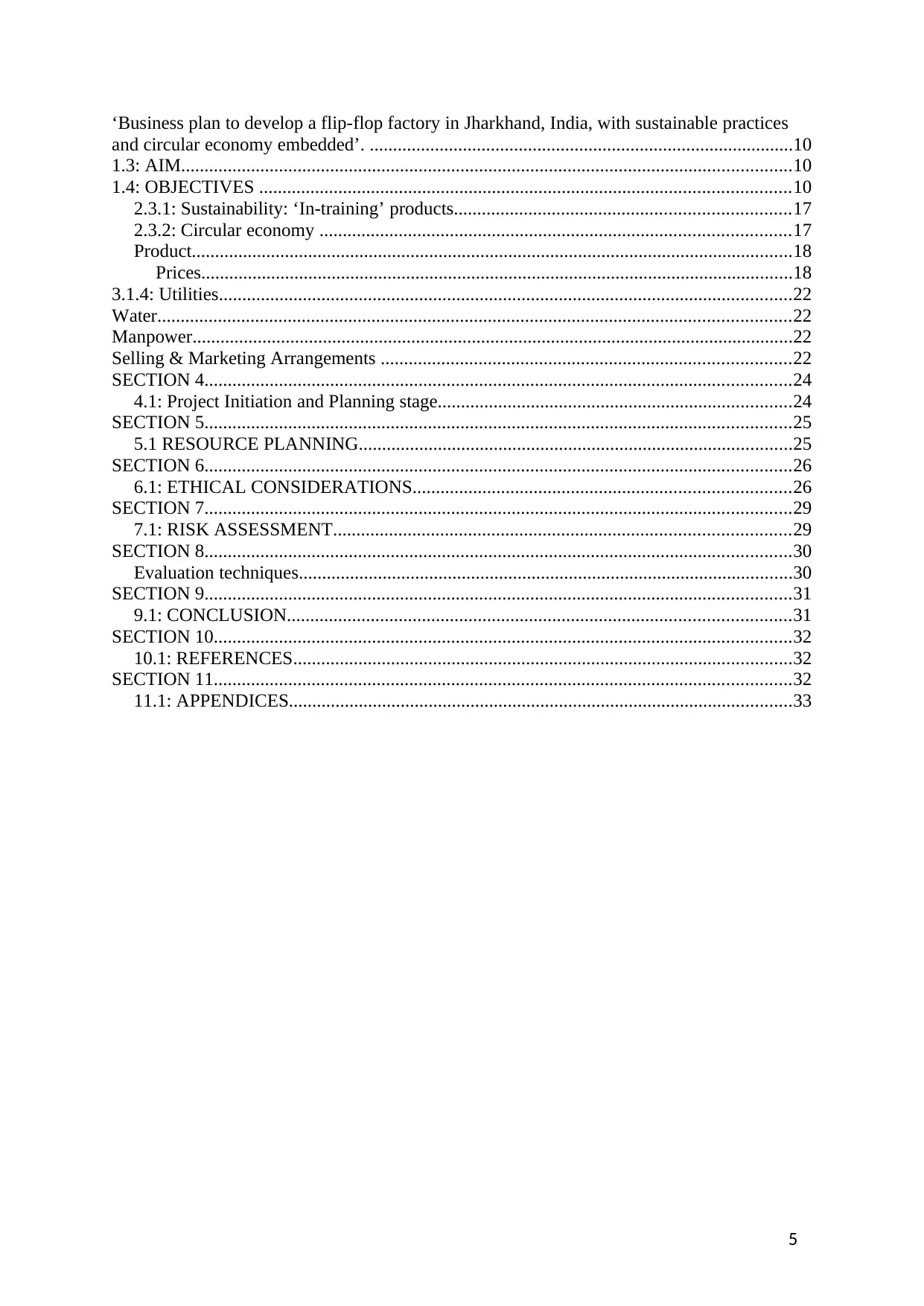
‘Business plan to develop a flip-flop factory in Jharkhand, India, with sustainable practices
and circular economy embedded’. ...........................................................................................10
1.3: AIM...................................................................................................................................10
1.4: OBJECTIVES ..................................................................................................................10
2.3.1: Sustainability: ‘In-training’ products........................................................................17
2.3.2: Circular economy .....................................................................................................17
Product.................................................................................................................................18
Prices...............................................................................................................................18
3.1.4: Utilities...........................................................................................................................22
Water........................................................................................................................................22
Manpower.................................................................................................................................22
Selling & Marketing Arrangements ........................................................................................22
SECTION 4..............................................................................................................................24
4.1: Project Initiation and Planning stage............................................................................24
SECTION 5..............................................................................................................................25
5.1 RESOURCE PLANNING.............................................................................................25
SECTION 6..............................................................................................................................26
6.1: ETHICAL CONSIDERATIONS.................................................................................26
SECTION 7..............................................................................................................................29
7.1: RISK ASSESSMENT..................................................................................................29
SECTION 8..............................................................................................................................30
Evaluation techniques..........................................................................................................30
SECTION 9..............................................................................................................................31
9.1: CONCLUSION............................................................................................................31
SECTION 10............................................................................................................................32
10.1: REFERENCES...........................................................................................................32
SECTION 11............................................................................................................................32
11.1: APPENDICES............................................................................................................33
5
and circular economy embedded’. ...........................................................................................10
1.3: AIM...................................................................................................................................10
1.4: OBJECTIVES ..................................................................................................................10
2.3.1: Sustainability: ‘In-training’ products........................................................................17
2.3.2: Circular economy .....................................................................................................17
Product.................................................................................................................................18
Prices...............................................................................................................................18
3.1.4: Utilities...........................................................................................................................22
Water........................................................................................................................................22
Manpower.................................................................................................................................22
Selling & Marketing Arrangements ........................................................................................22
SECTION 4..............................................................................................................................24
4.1: Project Initiation and Planning stage............................................................................24
SECTION 5..............................................................................................................................25
5.1 RESOURCE PLANNING.............................................................................................25
SECTION 6..............................................................................................................................26
6.1: ETHICAL CONSIDERATIONS.................................................................................26
SECTION 7..............................................................................................................................29
7.1: RISK ASSESSMENT..................................................................................................29
SECTION 8..............................................................................................................................30
Evaluation techniques..........................................................................................................30
SECTION 9..............................................................................................................................31
9.1: CONCLUSION............................................................................................................31
SECTION 10............................................................................................................................32
10.1: REFERENCES...........................................................................................................32
SECTION 11............................................................................................................................32
11.1: APPENDICES............................................................................................................33
5
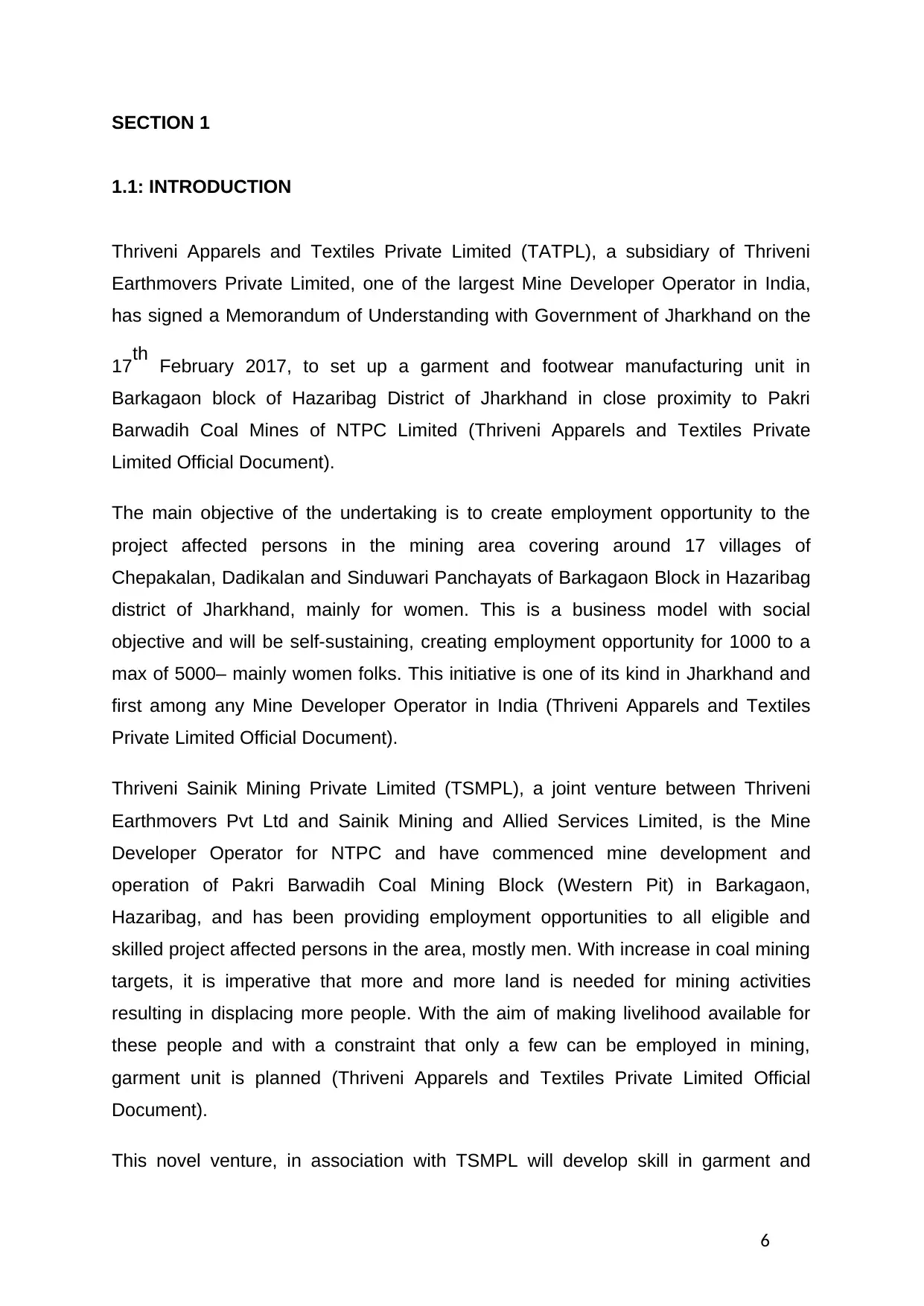
SECTION 1
1.1: INTRODUCTION
Thriveni Apparels and Textiles Private Limited (TATPL), a subsidiary of Thriveni
Earthmovers Private Limited, one of the largest Mine Developer Operator in India,
has signed a Memorandum of Understanding with Government of Jharkhand on the
17th February 2017, to set up a garment and footwear manufacturing unit in
Barkagaon block of Hazaribag District of Jharkhand in close proximity to Pakri
Barwadih Coal Mines of NTPC Limited (Thriveni Apparels and Textiles Private
Limited Official Document).
The main objective of the undertaking is to create employment opportunity to the
project affected persons in the mining area covering around 17 villages of
Chepakalan, Dadikalan and Sinduwari Panchayats of Barkagaon Block in Hazaribag
district of Jharkhand, mainly for women. This is a business model with social
objective and will be self-sustaining, creating employment opportunity for 1000 to a
max of 5000– mainly women folks. This initiative is one of its kind in Jharkhand and
first among any Mine Developer Operator in India (Thriveni Apparels and Textiles
Private Limited Official Document).
Thriveni Sainik Mining Private Limited (TSMPL), a joint venture between Thriveni
Earthmovers Pvt Ltd and Sainik Mining and Allied Services Limited, is the Mine
Developer Operator for NTPC and have commenced mine development and
operation of Pakri Barwadih Coal Mining Block (Western Pit) in Barkagaon,
Hazaribag, and has been providing employment opportunities to all eligible and
skilled project affected persons in the area, mostly men. With increase in coal mining
targets, it is imperative that more and more land is needed for mining activities
resulting in displacing more people. With the aim of making livelihood available for
these people and with a constraint that only a few can be employed in mining,
garment unit is planned (Thriveni Apparels and Textiles Private Limited Official
Document).
This novel venture, in association with TSMPL will develop skill in garment and
6
1.1: INTRODUCTION
Thriveni Apparels and Textiles Private Limited (TATPL), a subsidiary of Thriveni
Earthmovers Private Limited, one of the largest Mine Developer Operator in India,
has signed a Memorandum of Understanding with Government of Jharkhand on the
17th February 2017, to set up a garment and footwear manufacturing unit in
Barkagaon block of Hazaribag District of Jharkhand in close proximity to Pakri
Barwadih Coal Mines of NTPC Limited (Thriveni Apparels and Textiles Private
Limited Official Document).
The main objective of the undertaking is to create employment opportunity to the
project affected persons in the mining area covering around 17 villages of
Chepakalan, Dadikalan and Sinduwari Panchayats of Barkagaon Block in Hazaribag
district of Jharkhand, mainly for women. This is a business model with social
objective and will be self-sustaining, creating employment opportunity for 1000 to a
max of 5000– mainly women folks. This initiative is one of its kind in Jharkhand and
first among any Mine Developer Operator in India (Thriveni Apparels and Textiles
Private Limited Official Document).
Thriveni Sainik Mining Private Limited (TSMPL), a joint venture between Thriveni
Earthmovers Pvt Ltd and Sainik Mining and Allied Services Limited, is the Mine
Developer Operator for NTPC and have commenced mine development and
operation of Pakri Barwadih Coal Mining Block (Western Pit) in Barkagaon,
Hazaribag, and has been providing employment opportunities to all eligible and
skilled project affected persons in the area, mostly men. With increase in coal mining
targets, it is imperative that more and more land is needed for mining activities
resulting in displacing more people. With the aim of making livelihood available for
these people and with a constraint that only a few can be employed in mining,
garment unit is planned (Thriveni Apparels and Textiles Private Limited Official
Document).
This novel venture, in association with TSMPL will develop skill in garment and
6
⊘ This is a preview!⊘
Do you want full access?
Subscribe today to unlock all pages.

Trusted by 1+ million students worldwide
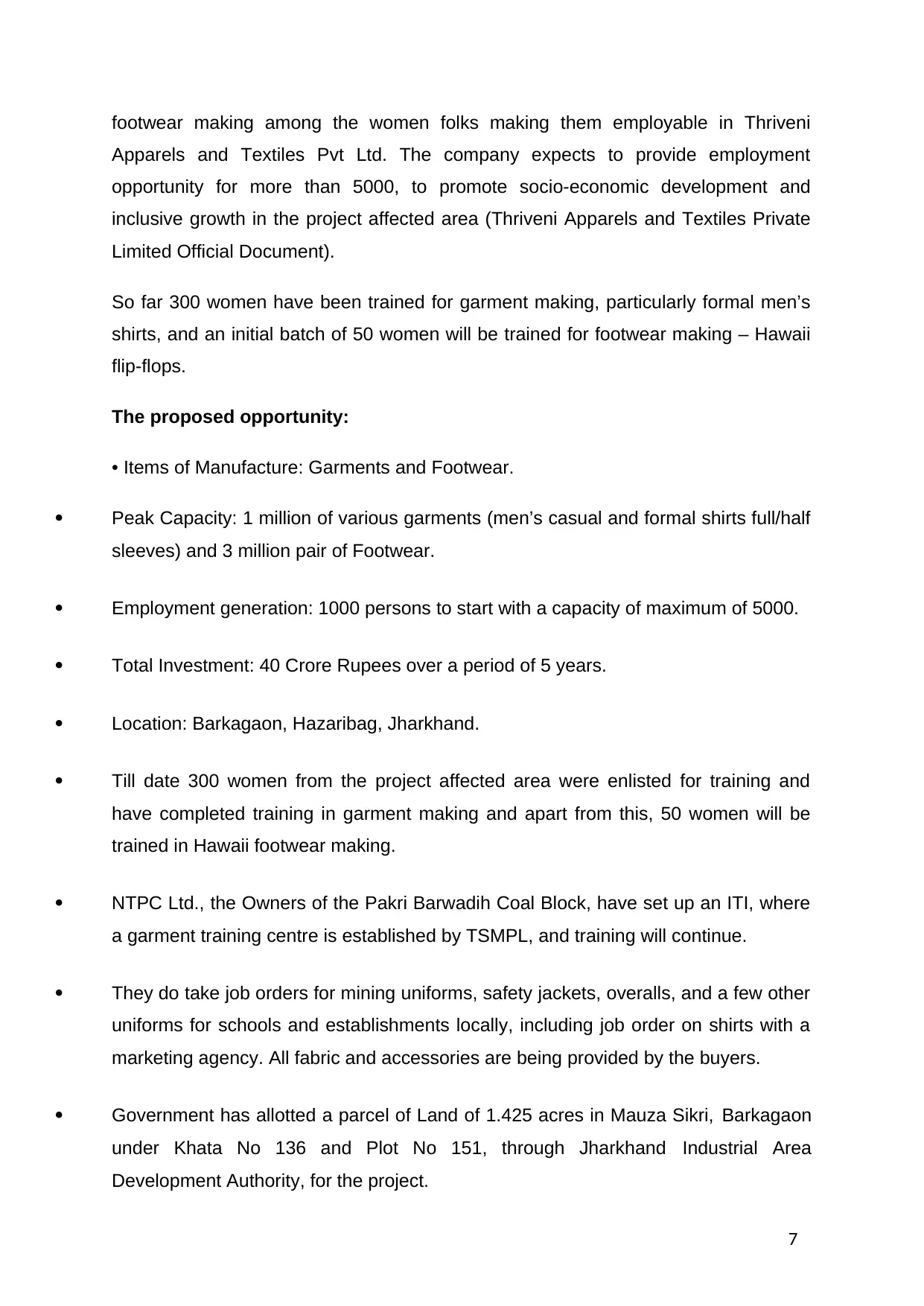
footwear making among the women folks making them employable in Thriveni
Apparels and Textiles Pvt Ltd. The company expects to provide employment
opportunity for more than 5000, to promote socio-economic development and
inclusive growth in the project affected area (Thriveni Apparels and Textiles Private
Limited Official Document).
So far 300 women have been trained for garment making, particularly formal men’s
shirts, and an initial batch of 50 women will be trained for footwear making – Hawaii
flip-flops.
The proposed opportunity:
• Items of Manufacture: Garments and Footwear.
Peak Capacity: 1 million of various garments (men’s casual and formal shirts full/half
sleeves) and 3 million pair of Footwear.
Employment generation: 1000 persons to start with a capacity of maximum of 5000.
Total Investment: 40 Crore Rupees over a period of 5 years.
Location: Barkagaon, Hazaribag, Jharkhand.
Till date 300 women from the project affected area were enlisted for training and
have completed training in garment making and apart from this, 50 women will be
trained in Hawaii footwear making.
NTPC Ltd., the Owners of the Pakri Barwadih Coal Block, have set up an ITI, where
a garment training centre is established by TSMPL, and training will continue.
They do take job orders for mining uniforms, safety jackets, overalls, and a few other
uniforms for schools and establishments locally, including job order on shirts with a
marketing agency. All fabric and accessories are being provided by the buyers.
Government has allotted a parcel of Land of 1.425 acres in Mauza Sikri, Barkagaon
under Khata No 136 and Plot No 151, through Jharkhand Industrial Area
Development Authority, for the project.
7
Apparels and Textiles Pvt Ltd. The company expects to provide employment
opportunity for more than 5000, to promote socio-economic development and
inclusive growth in the project affected area (Thriveni Apparels and Textiles Private
Limited Official Document).
So far 300 women have been trained for garment making, particularly formal men’s
shirts, and an initial batch of 50 women will be trained for footwear making – Hawaii
flip-flops.
The proposed opportunity:
• Items of Manufacture: Garments and Footwear.
Peak Capacity: 1 million of various garments (men’s casual and formal shirts full/half
sleeves) and 3 million pair of Footwear.
Employment generation: 1000 persons to start with a capacity of maximum of 5000.
Total Investment: 40 Crore Rupees over a period of 5 years.
Location: Barkagaon, Hazaribag, Jharkhand.
Till date 300 women from the project affected area were enlisted for training and
have completed training in garment making and apart from this, 50 women will be
trained in Hawaii footwear making.
NTPC Ltd., the Owners of the Pakri Barwadih Coal Block, have set up an ITI, where
a garment training centre is established by TSMPL, and training will continue.
They do take job orders for mining uniforms, safety jackets, overalls, and a few other
uniforms for schools and establishments locally, including job order on shirts with a
marketing agency. All fabric and accessories are being provided by the buyers.
Government has allotted a parcel of Land of 1.425 acres in Mauza Sikri, Barkagaon
under Khata No 136 and Plot No 151, through Jharkhand Industrial Area
Development Authority, for the project.
7
Paraphrase This Document
Need a fresh take? Get an instant paraphrase of this document with our AI Paraphraser
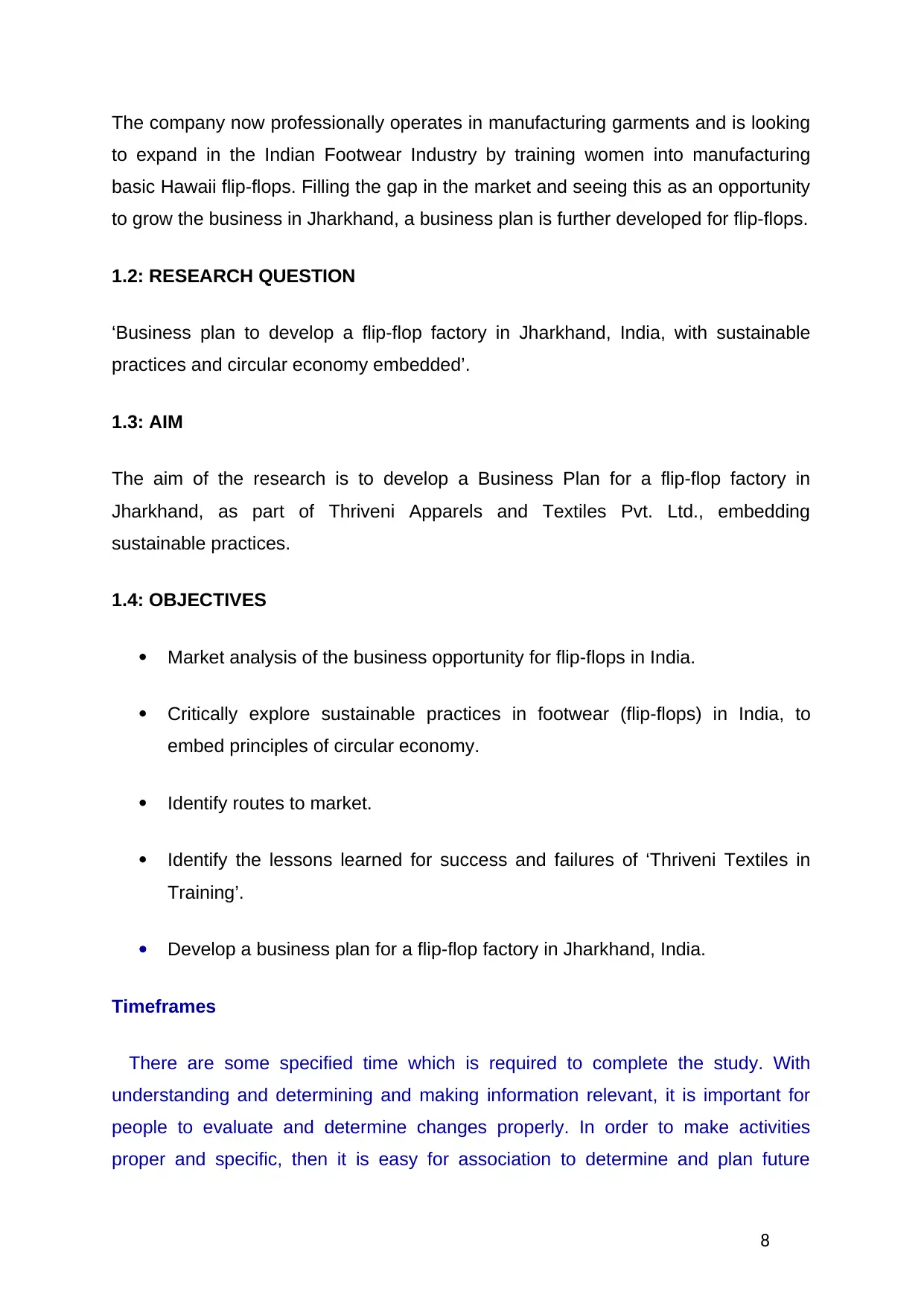
The company now professionally operates in manufacturing garments and is looking
to expand in the Indian Footwear Industry by training women into manufacturing
basic Hawaii flip-flops. Filling the gap in the market and seeing this as an opportunity
to grow the business in Jharkhand, a business plan is further developed for flip-flops.
1.2: RESEARCH QUESTION
‘Business plan to develop a flip-flop factory in Jharkhand, India, with sustainable
practices and circular economy embedded’.
1.3: AIM
The aim of the research is to develop a Business Plan for a flip-flop factory in
Jharkhand, as part of Thriveni Apparels and Textiles Pvt. Ltd., embedding
sustainable practices.
1.4: OBJECTIVES
Market analysis of the business opportunity for flip-flops in India.
Critically explore sustainable practices in footwear (flip-flops) in India, to
embed principles of circular economy.
Identify routes to market.
Identify the lessons learned for success and failures of ‘Thriveni Textiles in
Training’.
Develop a business plan for a flip-flop factory in Jharkhand, India.
Timeframes
There are some specified time which is required to complete the study. With
understanding and determining and making information relevant, it is important for
people to evaluate and determine changes properly. In order to make activities
proper and specific, then it is easy for association to determine and plan future
8
to expand in the Indian Footwear Industry by training women into manufacturing
basic Hawaii flip-flops. Filling the gap in the market and seeing this as an opportunity
to grow the business in Jharkhand, a business plan is further developed for flip-flops.
1.2: RESEARCH QUESTION
‘Business plan to develop a flip-flop factory in Jharkhand, India, with sustainable
practices and circular economy embedded’.
1.3: AIM
The aim of the research is to develop a Business Plan for a flip-flop factory in
Jharkhand, as part of Thriveni Apparels and Textiles Pvt. Ltd., embedding
sustainable practices.
1.4: OBJECTIVES
Market analysis of the business opportunity for flip-flops in India.
Critically explore sustainable practices in footwear (flip-flops) in India, to
embed principles of circular economy.
Identify routes to market.
Identify the lessons learned for success and failures of ‘Thriveni Textiles in
Training’.
Develop a business plan for a flip-flop factory in Jharkhand, India.
Timeframes
There are some specified time which is required to complete the study. With
understanding and determining and making information relevant, it is important for
people to evaluate and determine changes properly. In order to make activities
proper and specific, then it is easy for association to determine and plan future
8
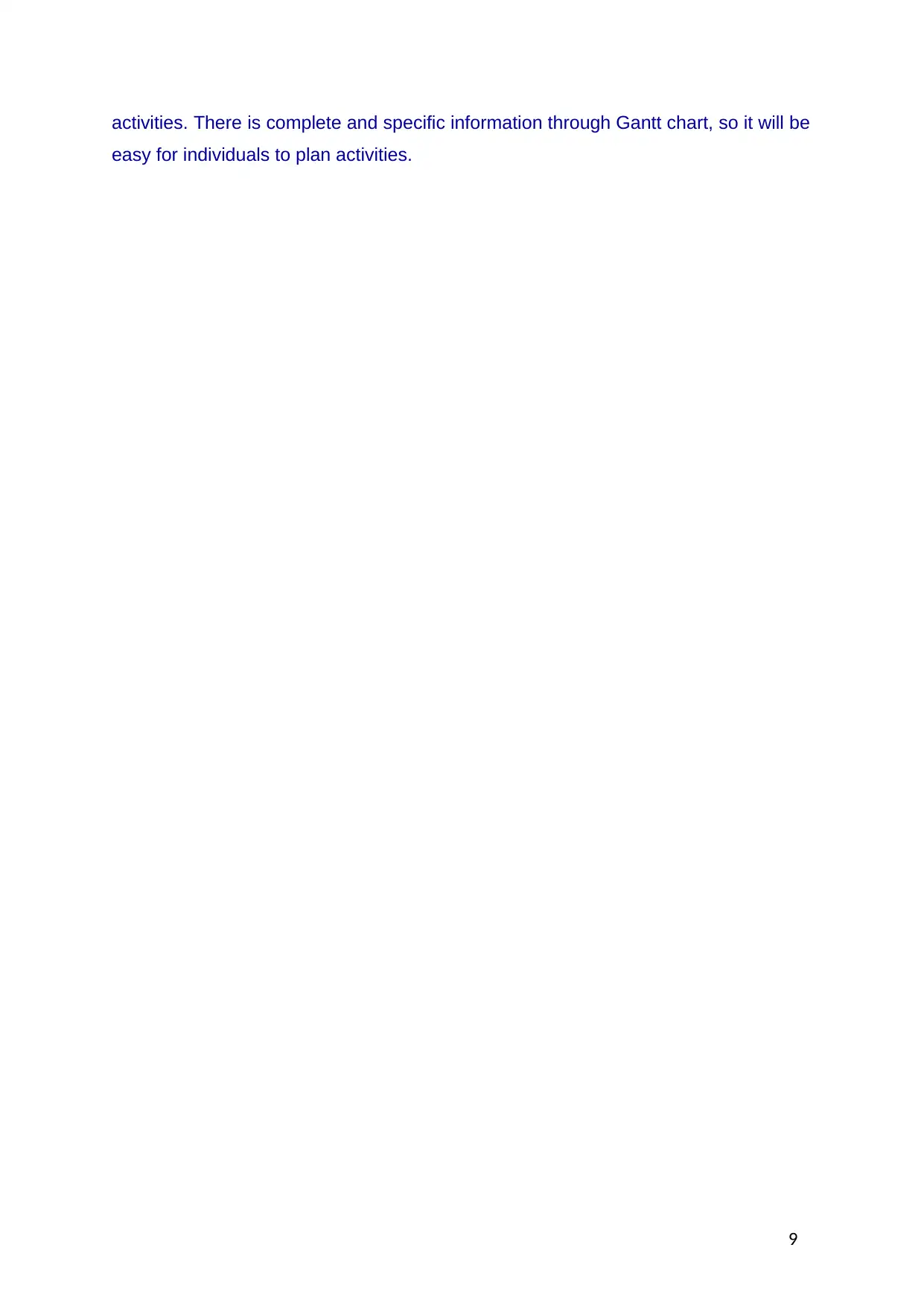
activities. There is complete and specific information through Gantt chart, so it will be
easy for individuals to plan activities.
9
easy for individuals to plan activities.
9
⊘ This is a preview!⊘
Do you want full access?
Subscribe today to unlock all pages.

Trusted by 1+ million students worldwide
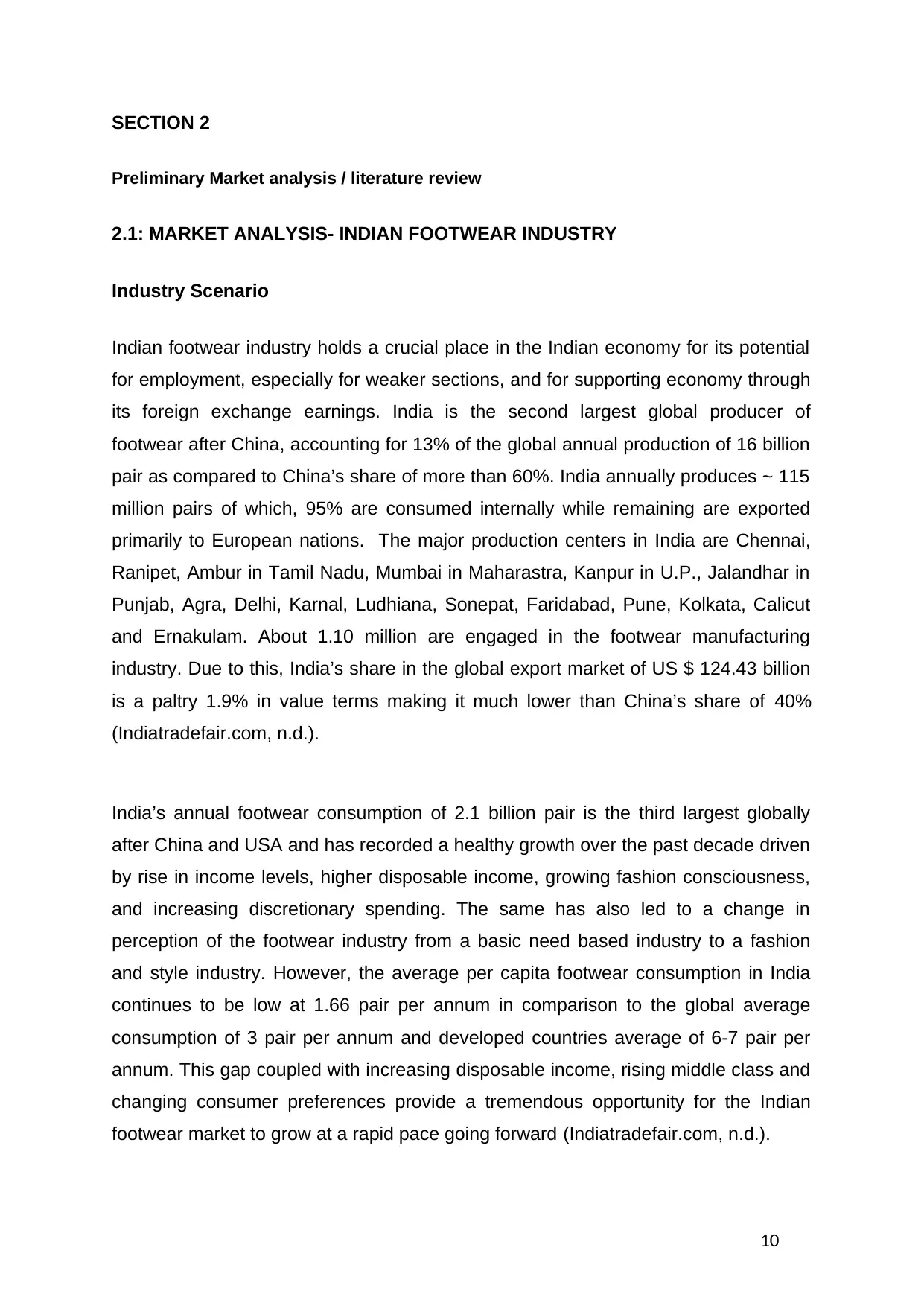
SECTION 2
Preliminary Market analysis / literature review
2.1: MARKET ANALYSIS- INDIAN FOOTWEAR INDUSTRY
Industry Scenario
Indian footwear industry holds a crucial place in the Indian economy for its potential
for employment, especially for weaker sections, and for supporting economy through
its foreign exchange earnings. India is the second largest global producer of
footwear after China, accounting for 13% of the global annual production of 16 billion
pair as compared to China’s share of more than 60%. India annually produces ~ 115
million pairs of which, 95% are consumed internally while remaining are exported
primarily to European nations. The major production centers in India are Chennai,
Ranipet, Ambur in Tamil Nadu, Mumbai in Maharastra, Kanpur in U.P., Jalandhar in
Punjab, Agra, Delhi, Karnal, Ludhiana, Sonepat, Faridabad, Pune, Kolkata, Calicut
and Ernakulam. About 1.10 million are engaged in the footwear manufacturing
industry. Due to this, India’s share in the global export market of US $ 124.43 billion
is a paltry 1.9% in value terms making it much lower than China’s share of 40%
(Indiatradefair.com, n.d.).
India’s annual footwear consumption of 2.1 billion pair is the third largest globally
after China and USA and has recorded a healthy growth over the past decade driven
by rise in income levels, higher disposable income, growing fashion consciousness,
and increasing discretionary spending. The same has also led to a change in
perception of the footwear industry from a basic need based industry to a fashion
and style industry. However, the average per capita footwear consumption in India
continues to be low at 1.66 pair per annum in comparison to the global average
consumption of 3 pair per annum and developed countries average of 6-7 pair per
annum. This gap coupled with increasing disposable income, rising middle class and
changing consumer preferences provide a tremendous opportunity for the Indian
footwear market to grow at a rapid pace going forward (Indiatradefair.com, n.d.).
10
Preliminary Market analysis / literature review
2.1: MARKET ANALYSIS- INDIAN FOOTWEAR INDUSTRY
Industry Scenario
Indian footwear industry holds a crucial place in the Indian economy for its potential
for employment, especially for weaker sections, and for supporting economy through
its foreign exchange earnings. India is the second largest global producer of
footwear after China, accounting for 13% of the global annual production of 16 billion
pair as compared to China’s share of more than 60%. India annually produces ~ 115
million pairs of which, 95% are consumed internally while remaining are exported
primarily to European nations. The major production centers in India are Chennai,
Ranipet, Ambur in Tamil Nadu, Mumbai in Maharastra, Kanpur in U.P., Jalandhar in
Punjab, Agra, Delhi, Karnal, Ludhiana, Sonepat, Faridabad, Pune, Kolkata, Calicut
and Ernakulam. About 1.10 million are engaged in the footwear manufacturing
industry. Due to this, India’s share in the global export market of US $ 124.43 billion
is a paltry 1.9% in value terms making it much lower than China’s share of 40%
(Indiatradefair.com, n.d.).
India’s annual footwear consumption of 2.1 billion pair is the third largest globally
after China and USA and has recorded a healthy growth over the past decade driven
by rise in income levels, higher disposable income, growing fashion consciousness,
and increasing discretionary spending. The same has also led to a change in
perception of the footwear industry from a basic need based industry to a fashion
and style industry. However, the average per capita footwear consumption in India
continues to be low at 1.66 pair per annum in comparison to the global average
consumption of 3 pair per annum and developed countries average of 6-7 pair per
annum. This gap coupled with increasing disposable income, rising middle class and
changing consumer preferences provide a tremendous opportunity for the Indian
footwear market to grow at a rapid pace going forward (Indiatradefair.com, n.d.).
10
Paraphrase This Document
Need a fresh take? Get an instant paraphrase of this document with our AI Paraphraser
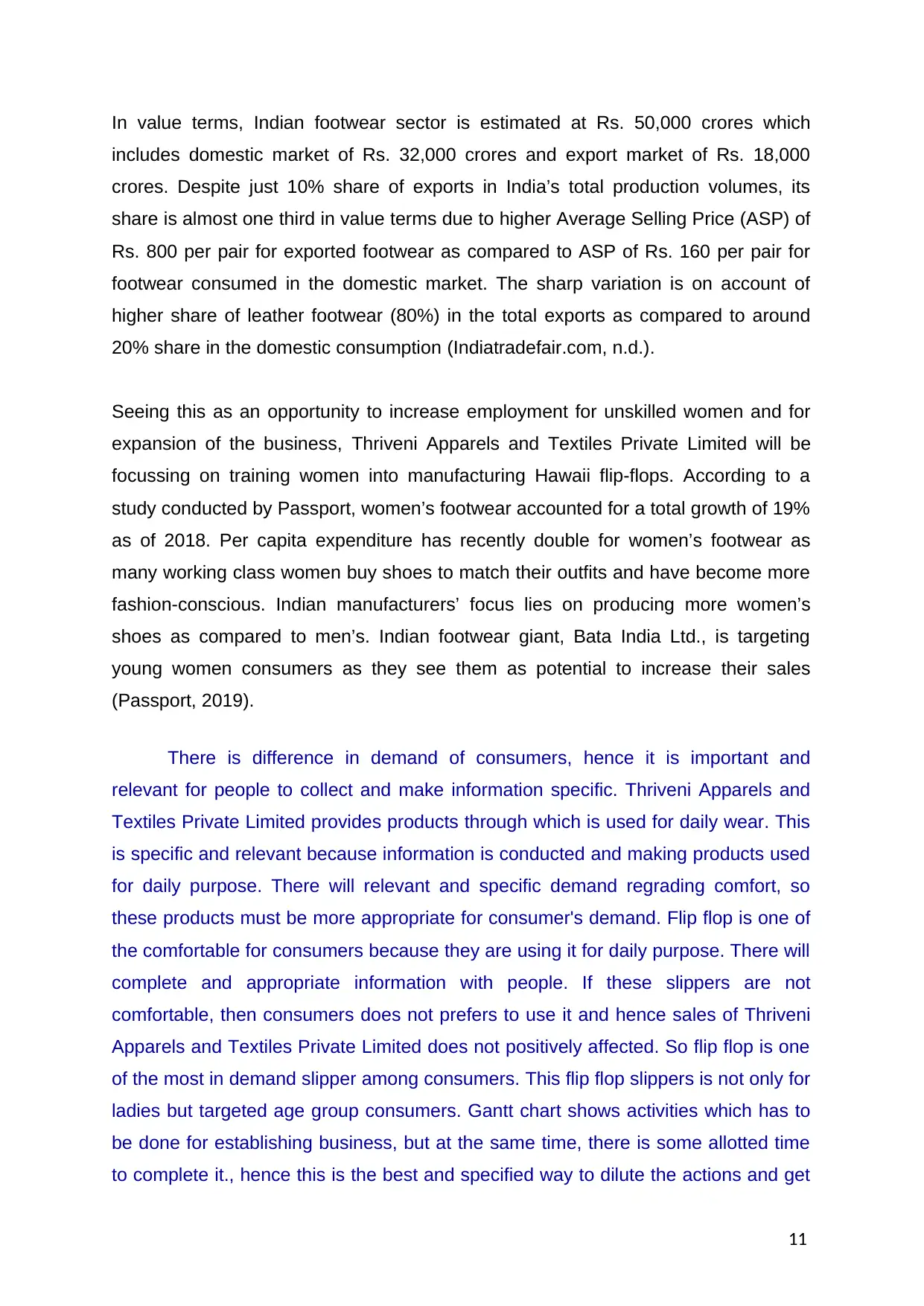
In value terms, Indian footwear sector is estimated at Rs. 50,000 crores which
includes domestic market of Rs. 32,000 crores and export market of Rs. 18,000
crores. Despite just 10% share of exports in India’s total production volumes, its
share is almost one third in value terms due to higher Average Selling Price (ASP) of
Rs. 800 per pair for exported footwear as compared to ASP of Rs. 160 per pair for
footwear consumed in the domestic market. The sharp variation is on account of
higher share of leather footwear (80%) in the total exports as compared to around
20% share in the domestic consumption (Indiatradefair.com, n.d.).
Seeing this as an opportunity to increase employment for unskilled women and for
expansion of the business, Thriveni Apparels and Textiles Private Limited will be
focussing on training women into manufacturing Hawaii flip-flops. According to a
study conducted by Passport, women’s footwear accounted for a total growth of 19%
as of 2018. Per capita expenditure has recently double for women’s footwear as
many working class women buy shoes to match their outfits and have become more
fashion-conscious. Indian manufacturers’ focus lies on producing more women’s
shoes as compared to men’s. Indian footwear giant, Bata India Ltd., is targeting
young women consumers as they see them as potential to increase their sales
(Passport, 2019).
There is difference in demand of consumers, hence it is important and
relevant for people to collect and make information specific. Thriveni Apparels and
Textiles Private Limited provides products through which is used for daily wear. This
is specific and relevant because information is conducted and making products used
for daily purpose. There will relevant and specific demand regrading comfort, so
these products must be more appropriate for consumer's demand. Flip flop is one of
the comfortable for consumers because they are using it for daily purpose. There will
complete and appropriate information with people. If these slippers are not
comfortable, then consumers does not prefers to use it and hence sales of Thriveni
Apparels and Textiles Private Limited does not positively affected. So flip flop is one
of the most in demand slipper among consumers. This flip flop slippers is not only for
ladies but targeted age group consumers. Gantt chart shows activities which has to
be done for establishing business, but at the same time, there is some allotted time
to complete it., hence this is the best and specified way to dilute the actions and get
11
includes domestic market of Rs. 32,000 crores and export market of Rs. 18,000
crores. Despite just 10% share of exports in India’s total production volumes, its
share is almost one third in value terms due to higher Average Selling Price (ASP) of
Rs. 800 per pair for exported footwear as compared to ASP of Rs. 160 per pair for
footwear consumed in the domestic market. The sharp variation is on account of
higher share of leather footwear (80%) in the total exports as compared to around
20% share in the domestic consumption (Indiatradefair.com, n.d.).
Seeing this as an opportunity to increase employment for unskilled women and for
expansion of the business, Thriveni Apparels and Textiles Private Limited will be
focussing on training women into manufacturing Hawaii flip-flops. According to a
study conducted by Passport, women’s footwear accounted for a total growth of 19%
as of 2018. Per capita expenditure has recently double for women’s footwear as
many working class women buy shoes to match their outfits and have become more
fashion-conscious. Indian manufacturers’ focus lies on producing more women’s
shoes as compared to men’s. Indian footwear giant, Bata India Ltd., is targeting
young women consumers as they see them as potential to increase their sales
(Passport, 2019).
There is difference in demand of consumers, hence it is important and
relevant for people to collect and make information specific. Thriveni Apparels and
Textiles Private Limited provides products through which is used for daily wear. This
is specific and relevant because information is conducted and making products used
for daily purpose. There will relevant and specific demand regrading comfort, so
these products must be more appropriate for consumer's demand. Flip flop is one of
the comfortable for consumers because they are using it for daily purpose. There will
complete and appropriate information with people. If these slippers are not
comfortable, then consumers does not prefers to use it and hence sales of Thriveni
Apparels and Textiles Private Limited does not positively affected. So flip flop is one
of the most in demand slipper among consumers. This flip flop slippers is not only for
ladies but targeted age group consumers. Gantt chart shows activities which has to
be done for establishing business, but at the same time, there is some allotted time
to complete it., hence this is the best and specified way to dilute the actions and get
11
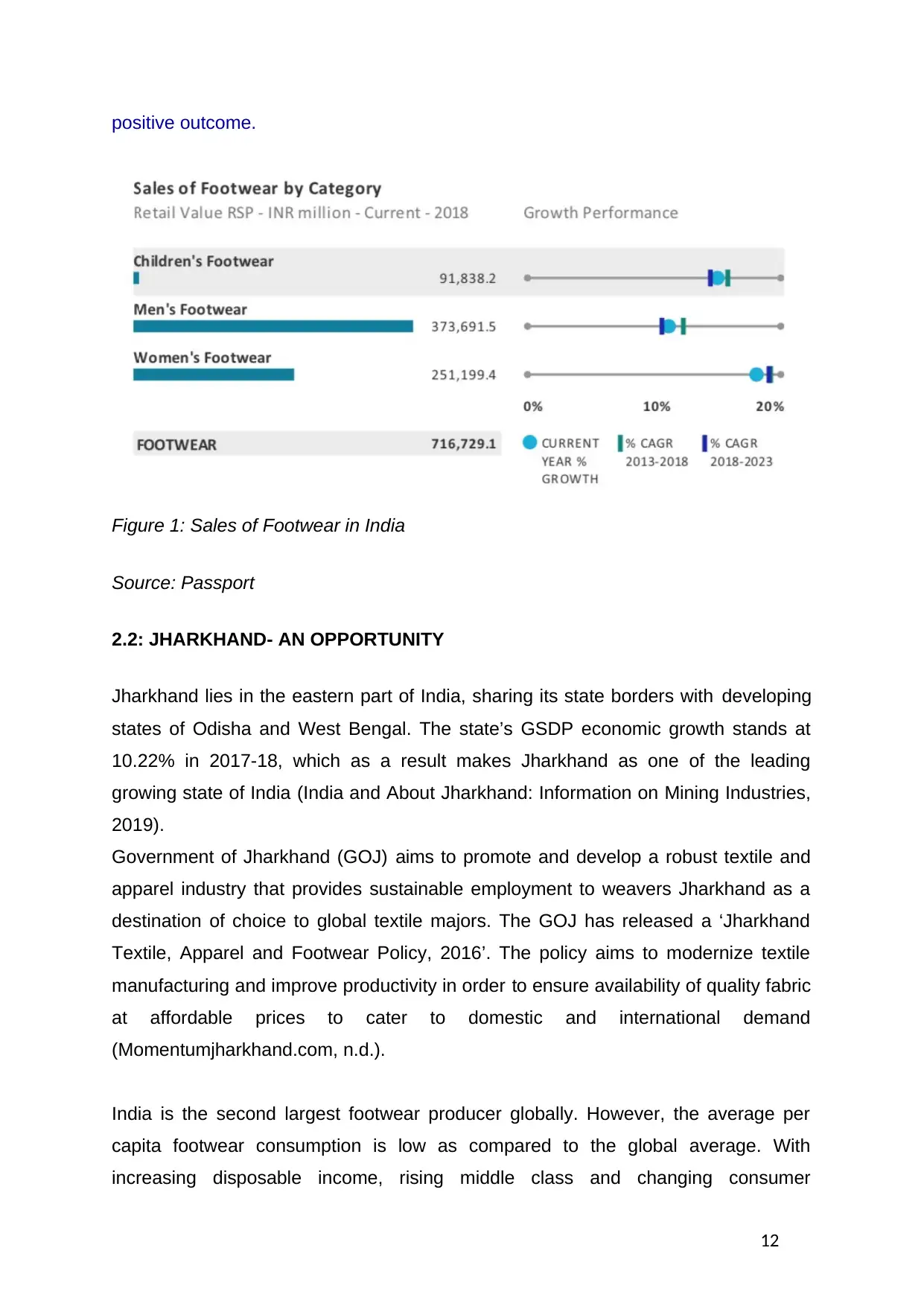
positive outcome.
Figure 1: Sales of Footwear in India
Source: Passport
2.2: JHARKHAND- AN OPPORTUNITY
Jharkhand lies in the eastern part of India, sharing its state borders with developing
states of Odisha and West Bengal. The state’s GSDP economic growth stands at
10.22% in 2017-18, which as a result makes Jharkhand as one of the leading
growing state of India (India and About Jharkhand: Information on Mining Industries,
2019).
Government of Jharkhand (GOJ) aims to promote and develop a robust textile and
apparel industry that provides sustainable employment to weavers Jharkhand as a
destination of choice to global textile majors. The GOJ has released a ‘Jharkhand
Textile, Apparel and Footwear Policy, 2016’. The policy aims to modernize textile
manufacturing and improve productivity in order to ensure availability of quality fabric
at affordable prices to cater to domestic and international demand
(Momentumjharkhand.com, n.d.).
India is the second largest footwear producer globally. However, the average per
capita footwear consumption is low as compared to the global average. With
increasing disposable income, rising middle class and changing consumer
12
Figure 1: Sales of Footwear in India
Source: Passport
2.2: JHARKHAND- AN OPPORTUNITY
Jharkhand lies in the eastern part of India, sharing its state borders with developing
states of Odisha and West Bengal. The state’s GSDP economic growth stands at
10.22% in 2017-18, which as a result makes Jharkhand as one of the leading
growing state of India (India and About Jharkhand: Information on Mining Industries,
2019).
Government of Jharkhand (GOJ) aims to promote and develop a robust textile and
apparel industry that provides sustainable employment to weavers Jharkhand as a
destination of choice to global textile majors. The GOJ has released a ‘Jharkhand
Textile, Apparel and Footwear Policy, 2016’. The policy aims to modernize textile
manufacturing and improve productivity in order to ensure availability of quality fabric
at affordable prices to cater to domestic and international demand
(Momentumjharkhand.com, n.d.).
India is the second largest footwear producer globally. However, the average per
capita footwear consumption is low as compared to the global average. With
increasing disposable income, rising middle class and changing consumer
12
⊘ This is a preview!⊘
Do you want full access?
Subscribe today to unlock all pages.

Trusted by 1+ million students worldwide
1 out of 39
Your All-in-One AI-Powered Toolkit for Academic Success.
+13062052269
info@desklib.com
Available 24*7 on WhatsApp / Email
![[object Object]](/_next/static/media/star-bottom.7253800d.svg)
Unlock your academic potential
Copyright © 2020–2025 A2Z Services. All Rights Reserved. Developed and managed by ZUCOL.


